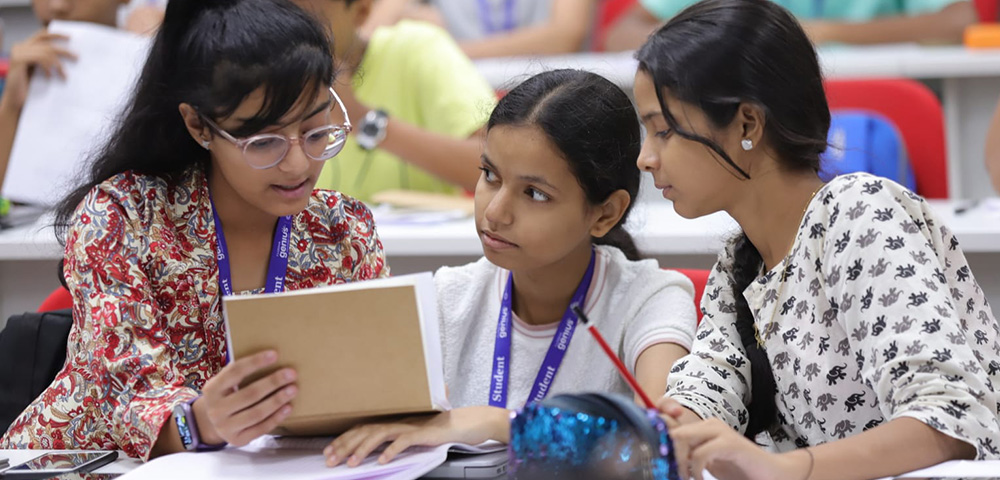Uncovering Brilliance: The Path to Identifying Gifted Minds
By lodha
July 03, 2025

The word genius often conjures images of prodigious talent: children who solve complex equations before they can spell them, or compose symphonies while their peers are still learning scales. Yet, in truth, giftedness can be far more nuanced and diverse. It may present itself not just in academic brilliance, but in emotional insight, creative expression, or an uncanny ability to see patterns others overlook.
Identifying such potential is both an art and a science. It requires tools that go beyond traditional benchmarks, and a mindset that appreciates the many dimensions of intelligence. This is particularly important in today’s world, where rigid systems may still struggle to recognise giftedness in its quieter, less conventional forms. From linguistic and cultural bias to late bloomers and underachievers, many children with exceptional abilities remain hidden in plain sight.
In this blog, we explore the most trusted assessments used globally to identify gifted children, while also shedding light on the challenges that often cloud this delicate process.
The Most Common Assessments for Giftedness
Globally, several standardised assessments are employed to evaluate children’s cognitive capabilities and potential. These include IQ testing, non-verbal reasoning tests, and domain-specific evaluations that help determine aptitude across a broad spectrum.
Wechsler Intelligence Scale for Children (WISC-V)
Arguably the most widely used test, the WISC-V offers a comprehensive overview of a child's intellectual abilities. It evaluates five key domains: verbal comprehension, visual-spatial skills, fluid reasoning, working memory, and processing speed. Its broad scope allows educators to observe a child’s strengths across multiple dimensions of intelligence.
Stanford-Binet Intelligence Scales (SB-5)
The Stanford Binet Intelligence Test measures a range of cognitive skills, including quantitative reasoning, visual-spatial processing, and knowledge application. It's widely considered one of the best IQ tests for identifying giftedness in younger children.
Cognitive Abilities Test (CogAT)
Used extensively in schools, the CogAT measures reasoning abilities in verbal, quantitative, and nonverbal domains. While not an IQ test in the traditional sense, it provides a useful gauge of a child’s aptitude for learning and problem-solving.
Naglieri Nonverbal Ability Test (NNAT)
Designed to reduce cultural and linguistic bias, the Naglieri Nonverbal Ability Test uses abstract shapes and patterns to assess problem-solving skills and pattern recognition. It’s particularly suited for identifying giftedness in students from diverse linguistic or socioeconomic backgrounds.
Raven’s Progressive Matrices Test
The Raven's Progressive Matrices Test is another widely used non-verbal reasoning test that measures abstract thinking and fluid intelligence. Its universal design allows educators to compare results across different linguistic and cultural groups with greater fairness.
The Challenges of Testing for Giftedness
While these assessments provide critical data, they are not without limitations. The landscape of gifted identification is fraught with nuance, and a truly equitable approach requires acknowledging the barriers that often stand in the way.
Over-Reliance on IQ Scores
A high IQ may signify advanced reasoning, but it is far from the only measure of giftedness. Creativity, leadership, artistic ability, and emotional insight are all forms of intelligence that standard tests may overlook. A narrow focus on IQ testing alone risks excluding children with extraordinary yet non-traditional strengths.
Socioeconomic and Cultural Bias
Standardised testing often reflects the cultural norms of the population it was designed for. Children from underrepresented communities may not perform optimally, not due to lack of ability, but due to unfamiliarity with test formats or implicit bias in question design. This makes it crucial for identification systems to be both inclusive and culturally responsive. Accessible scholarship opportunities and inclusive testing models can help bridge this gap.
Emotional and Social Development Gaps
Gifted children do not always develop evenly across emotional, intellectual, and social domains. Some may struggle with peer relationships or exhibit heightened sensitivity, masking their true capabilities. In such cases, giftedness may go unnoticed or be misdiagnosed as behavioural difficulty.
Late Bloomers and Underachievers
Not all gifted children show early signs of brilliance. Some may underperform in structured settings, especially if uninspired by traditional curricula. These ‘late bloomers’ or ‘twice-exceptional’ learners (gifted students with learning differences) are frequently misclassified, necessitating a more holistic approach to identification.
Equitable Access to Testing
Formal assessments can be expensive and are often only available through private channels or elite institutions. This restricts access for many deserving students, perpetuating cycles of exclusion. Ensuring that gifted testing is widely accessible is key to nurturing talent irrespective of background.
Towards a More Nuanced Understanding
In identifying genius, it is imperative to look beyond the numbers. A multifaceted, culturally attuned, and empathetic approach is not just ideal, it is essential. The true hallmark of a gifted education programme lies not in its ability to rank intelligence, but in its commitment to recognising and nurturing potential in all its varied and remarkable forms.
If you believe your child may be gifted or has already been identified as such, the Lodha Genius Programme offers a thoughtfully curated environment designed to meet their unique educational and emotional needs. With a focus on holistic development, specialised mentorship, and peer collaboration, the scholarship program is built to unlock true potential and support gifted learners as they shape their own path to excellence.
You may also like



 Enquire
Enquire
 Call
Call
 chat
chat
 Search
Search





